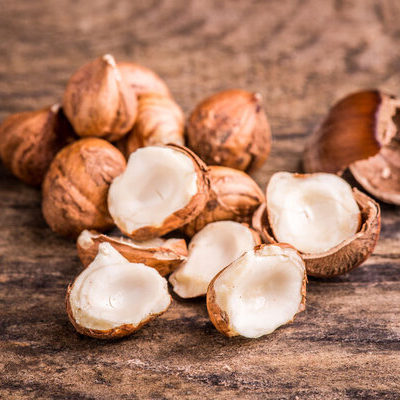
Hazelnut
also known as Filberts, Filbert Nuts
What is Hazelnut?
Hazelnut (Corylus avellana L) is a brown, round, or oval-shaped fruit or nut from the hazel tree. This nut grows inside of a hard, protective husk or shell. It can be found shelled or in-shell in most supermarkets.
- While they can be eaten raw, hazelnuts can also be prepared for both sweet and savory dishes.
- One popular food to combine hazelnuts with is chocolate.
The top three most common varieties of this nut are:
- Corylus avellana racemosa Lam (They are grouped in a cluster and are very voluminous.)
- Corylus avellana glandulosa Lin (These are nuts with an acorn or cone shape and narrower base.)
- Corylus avellana Máxima Lam (They are round with a hard shell.)
Origin of hazelnut
The existence of this nut dates back 10,000 years ago to the Mesolithic and Neolithic eras. Later on, the hazelnut was discovered in Asia Minor. China was most likely its place of origin, as an ancient Chinese manuscript mentions the nut. It was used for years in Asian countries like Korea until the Romans and Greeks introduced it to Europe. Today, it is widely used in Europe, especially in countries like Italy. The discovery of the nutritional benefits of this nut led many countries to begin its cultivation and increased availability of it in different varieties.
Function
This nut can be used in the kitchen for baking, confectionaries, and making desserts. Hazelnuts are also great for preparing pastas, nut butters, nut milks, liqueurs, flour or oils. As a flavoring, it is commonly used in creamers and sweets such as chocolate.
Nutrition
A 100g serving of this nut contains:

This food has many health benefits, which are also good for the skin. It may help with bodyweight reduction and lower the risk of obesity, as well as prevent heart problems. Also, this food contains antioxidants that can help protect cells from damage. This nut also contains valuable nutrients like fatty acids that are good for keeping the skin hydrated. Not to mention, this nut’s oil contains calcium that is good for dry skin and helps cure eczema. Nonetheless, people with nut allergies may find their bodies reacting to this food and should avoid consumption or topical application of it.
Commercial production
The commercial production of this nut starts with planting seeds in dry and reasonably rich soil. Next, the nuts must be harvested. When their husk turns yellow, it signifies they are ripe and ready to be harvested. It takes about nine months for newly planted hazelnuts to ripen, which allows for harvesting once a year. When harvesting this nut, the weeds are cleared out with a weed puller to ease the process. On the other hand, the production of this nut’s essential oil happens through extraction and the grounding of the nut into powder form. The extraction requires a cold-pressed machine used to press the nut and extract the oil.
Application
These nuts can be grown at home, if you have the space and means. No matter whether you buy them or grow them, this nut should be kept in a cool, dry place. Since nuts contain high levels of oil, they tend to go rancid when exposed to oxygen.
Hazelnut recipes
This nut makes a great addition to many dishes. Here are some popular recipes to try:
- Hazelnut and Oregano Pasta
- Italian Olive Oil Cake
- Chocolate Truffles
- Hazelnut Cookie
- Coffee-Hazelnut Biscotti
FDA Regulations
The FDA defines hazelnuts as a food that is rarely consumed raw, and therefore, does not regulate their growing, harvesting, and packaging. However, the FDA, by virtue of its Food Allergen Labeling and Consumer Protection Act of 2004 (P.L. 108-282) (FALCPA), requires the proper labeling of any food that contains a “major food allergen”, which includes all nuts. FALCPA defines a “major food allergen” as one of eight foods or a food ingredient that contains protein derived from one of those foods.
References
“Complete Guide to Hazelnuts: Culinary Uses and Health Benefits of Hazelnuts – 2021.” MasterClass, MasterClass, 8 Nov. 2020, www.masterclass.com/articles/complete-guide-to-hazelnuts#what-are-the-different-ways-to-eat-or-cook-with-hazelnuts.
“8 Health Benefits of Hazelnuts.” Medical News Today, MediLexicon International, www.medicalnewstoday.com/articles/323807#8-benefits
Benedict, Vanheems, “A Guide to Growing Your Own Hazelnuts” https://www.growveg.com/guides/a-guide-to-growing-your-own-hazelnuts/#:~:text=Hazelnuts%20prefer%20soil%20that%20well,expense%20of%20flowers%20and%20nuts
